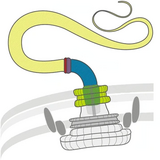| Part of a series on |
| Microbial and microbot movement |
|---|
 |
| Microswimmers |
| Molecular motors |
Gliding motility is a type of translocation used by microorganisms that is independent of propulsive structures such as flagella, pili, and fimbriae.[1] Gliding allows microorganisms to travel along the surface of low aqueous films. The mechanisms of this motility are only partially known.
Twitching motility also allows microorganisms to travel along a surface, but this type of movement is jerky and uses pili as its means of transport. Bacterial gliding is a type of gliding motility that can also use pili for propulsion.
The speed of gliding varies between organisms, and the reversal of direction is seemingly regulated by some sort of internal clock.[2] For example the apicomplexans are able to travel at fast rates between 1–10 μm/s. In contrast Myxococcus xanthus bacteria glide at a rate of 0.08 μm/s.[3][4]
- ^ Nan, Beiyan (February 2017). "Bacterial gliding motility: Rolling out a consensus model". Current Biology. 27 (4): R154 – R156. doi:10.1016/j.cub.2016.12.035. PMID 28222296.
- ^ Nan, Beiyan; McBride, Mark J.; Chen, Jing; Zusman, David R.; Oster, George (February 2014). "Bacteria that glide with helical tracks". Current Biology. 24 (4): 169–174. doi:10.1016/j.cub.2013.12.034. PMC 3964879. PMID 24556443.
- ^ Sibley, L. David; Håkansson, Sebastian; Carruthers, Vern B. (1998-01-01). "Gliding motility: An efficient mechanism for cell penetration". Current Biology. 8 (1): R12 – R14. doi:10.1016/S0960-9822(98)70008-9. PMID 9427622.
- ^ Sibley, L.D.I. (October 2010). "How apicomplexan parasites move in and out of cells". Current Opinion in Biotechnology. 21 (5): 592–8. doi:10.1016/j.copbio.2010.05.009. PMC 2947570. PMID 20580218.
